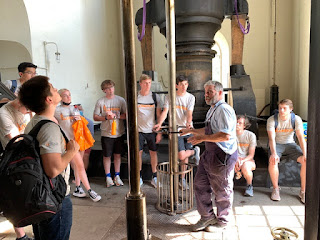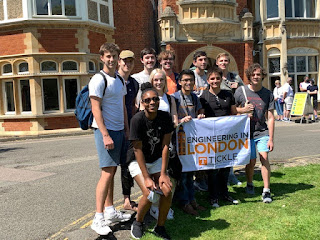Congratulations to our 2021 class of the Engineering in London (EIL) study abroad program! Two group photos from the banquet dinner at Brown's of Covent Garden on Friday, July3 28 are provided below. Zosia Rutkowska from IES and Kathleen Parsons (Prof. Parson's wfie) were our special guests. Prof. Parsons received a special gift in lieu of his retirement from teaching in the EIL program. Click here for the final slideshow of the program created by Ben Pham.
Friday, July 23, 2021
Banquet at Brown's in Covent Garden
Tuesday, July 20, 2021
Crosswalk Lab in ECE 301 using an Arduino Kit
Continuing the project work initiated with the EIL 2019 program, this year's students were given an assignment to build a prototype crosswalk emulator using an Arduino kit. Many of the crosswalks in London do not have sound to alert pedestrians that the time window for crossing the street is abruptly closing. This lab assignment, originally designed by Ben Sergent (UTK/EECS BS/MS Computing Eng. alumnus) and edited by Dean Vookles, the ECE 301 UTA (Undergraduate Teaching Assistant) and EE major, allowed the students in ECE 301 to get a real feel for electrical components and learn how microcontrollers generally work with digital circuitry. The functioning prototype shown below was completed by seven groups of two with each group finishing a stage of the project and handing off their progress to the next group. Amazingly, the entire project was completed in about four hours after a ME 331 lab session. Below is a short video that constituted part of the demonstration of the crosswalk emulator to Profs. Berry and Parsons on Wednesday, July 20.
Monday, July 19, 2021
London Eye
On Monday evening (July 19), the EIL students joined Prof. Berry to experience the London Eye - a cantilevered observation wheel on the South Bank of the River Thames in London. It is Europe's tallest cantilevered observation wheel, is the most popular paid tourist attraction in the United Kingdom with over 3.75 million visitors annually, and has made many appearances in popular culture. The structure is 135 metres (443 ft) tall and the wheel has a diameter of 120 metres (394 ft).
Sunday, July 18, 2021
London Water and Steam Museum (Kew Bridge)
On Sunday afternoon, July18, the EIL students along with Prof. Berry visited the London Museum of Water and Steam (formerly Kew Bridge Steam Museum) at Kew Bridge. They witnessed the startup of the three-story Bull Engine (named for Cornish engineer Edward Bull) that began pumping in 1859. Our guide, Richard, did a marvelous job of presenting the history of each of the steam machines visited and the group photo was taken with him in front of the Easton and Amos that was running at the time. The tour this year also included the boiler room, tool and parts shop, and the Victorian tool and blacksmith workshops. The students were also shown the 90-inch Grand Junction Engine (the largest working beam engine in the world) and the Boulton and Watt engine (built in 1820) that was moved to Kew Bridge from the Grand Junction Waterworks Company's Chelsea works in 1840. Before leaving the Museum, the students competed in an untouchable bubble relay.
Friday, July 16, 2021
Bletchley Park
On a beautiful Friday, July 16, the EIL students along with Profs. Berry and Parsons and Zosia Rutkowska from IES visited Bletchley Park (north of London). Bletchley Park is where Alan Turing and his colleagues in Hut 8 broke the (naval) Enigma code during World War II. The students witnessed demonstrations of working Enigma, Bombe, Tunny, Harwell Dekatron, and Colossus machines. The Colossus was the world's first electric digital computer that was programmable. The Colossus computers were developed to help in the cryptanalysis of the Hitler's Lorenz cipher. Nicknamed WITCH for Wolverhampton Instrument for Teaching Computing from Harwell, the Harwell Dekatron at the National Museum of Computing (NMC) is considered the oldest electronic computer that is still operational. Our guides, John and Peter, and the other volunteers at the NMC were excellent. The students utilized part of their lunch break to burn off some energy on the jungle gym equipment near the Bletchley Park Mansion.
Wednesday, July 14, 2021
Romeo and Juliet at the Globe Theatre
On Tuesday evening, July 13, the EIL students accompanied by Profs. Berry and Parsons went to see Romeo and Juliet at the Globe Theatre on the banks of the Thames River. This production was fairly modern and abridged (only two hours with no intermission). A few photos were taken at the end of the performance along with a group photo of all the EIL students on the bank of the Thames (with a view of St. Paul's Cathedral in the distance).
Saturday, July 10, 2021
Thermodynamics Lab
All EIL students take ECE 301 (Circuits) and ME 331 (Thermodynamics) here in London and earn 6 credit hours of technical elective credits toward their major. Here are a few photos taken during recent afternoon Thermodynamics lab periods. Students are assigned problems (in groups) to work out on the board and one of group members must explain their solution strategy to the entire class and Prof. Parsons.
Wednesday, July 7, 2021
Greenwich
On Wednesday, July 7, the EIL students along with Profs. Berry and Parsons took an Uber boat up the Thames River to Greenwich. At Greenwich, they visited the Cutty Sark ship, Royal Maritime Museum, the Queen's House, and the Royal Observatory. In the Time and Longitude Gallery of the Flamsteed House at the Royal Observatory, students were able to see Harrison's sea clocks from the eighteenth century. Harrison's H4 clock is considered the most important timekeeper ever made. It is the machine that helped solve the problem of keeping accurate time at sea and finally won Harrison huge rewards from the Board of Longitude and the British Government. As is customary, group photos were taken at the Prime Meridian (Longitude 0) and with Southeast London as the background. The final excursion of the day was a short bus ride to the Thames Barrier, just north of the Greenwich Town Centre. Operated by the Environment Agency of the British government, the Thames Barrier is one of the largest movable flood barriers in the world.
Tuesday, July 6, 2021
Brunel Museum
On Tuesday afternoon (July 6), the EIL students joined Profs. Berry and Parsons for a visit to the Brunel Museum at Rotherhithe on the bank of the Thames River. In the original shaft of the tunnel (under the Thames River) that Marc and Isambard (Kingdom) Brunel designed and built, our guide (Kal) gave an excellent historical timeline for this great nineteenth century engineering achievement. Completed in 1834, this was the world's first underwater tunnel. Isambard Brunel was considered by many to be the greatest engineer of Victorian England.
Sunday, July 4, 2021
Westminster Abbey Sunday Eucharist Service
Eight EIL students joined Professor Berry, Professor Parsons and his wife, Kathleen, in attending the 11:15am Eucharist service at Westminster Abbey (Church of England) on Sunday, July 4. In addition to the angelic voices of the choir and spiritual readings and prayers given by worship leaders, the students were able to see the tombs of both Sir Issac Newton and James Prescott Joule as they made their way through the halls of the Abbey. After the service, the group enjoyed tea and cakes at Caffé Concerto in Whitehall (near Traflagar Square).




















































